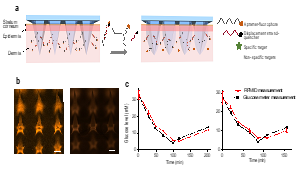Background
Transdermal biosensing is important to personalized and precision medicine as it enables tracking of patient health conditions in a non or minimally invasive manner. Transdermal biosensors analyze interstitial fluid (ISF), the fluid which is present in the lowermost skin layer of the dermis, for biomarker measurements. Microneedle (MN) devices enables ISF analysis in a minimally invasive manner and in point-of-care settings, however, most MN-based diagnostic approaches require complicated fabrication processes, post-processing of the extracted ISF, or are limited to detection of electrochemically active biomarkers. A reagentless, generalizable assay for the detection of a wide range of diagnostic biomarkers that are integrated with MNs has the potential to revolutionize the health care system.
Description of the invention
Using a unique Hydrogel MicroNeedle (HMN) platform linked with aptamer probes, researchers at the University of Waterloo have invented a reagentless biosensor that enables rapid (in 2 min) detection of biomarkers in a non-invasive/minimally invasive manner. The biosensor can potentially track various biological substances of interest in a range of medical applications and can be designed/fine-tuned to be only responsive to certain “target analytes”. The assay operates when exposed to body liquids such as ISF without any sample preparation or need for adding reagents.
Advantages
- Enables reagentless detection of analytes
- Simple and Point of Care (POC) implementable
- Fast and stable detection of analytes
- No sample preparation
Potential applications
- Personalized/precision medicine
- Therapeutics clinical trials
- Diabetes management via continuous glucose measurement/ monitoring

Basis of aptamer HMN biosensor and aptamer functionalization. A. Schematic of target detection of aptamer HMN biosensor. B. Fluorescence image of HMN patch functionalized with an aptamer probe only (left) or aptame-quencher complex (right). C. Glucose detection in diabetic rats using our approach
Reference
10200 & 10199
Patent status
Patent pending
Stage of development
Prototype
Ongoing research
Contact
Scott Inwood
Director of Commercialization
Waterloo Commercialization Office
519-888-4567, ext. 43728
sinwood@uwaterloo.ca
uwaterloo.ca/research